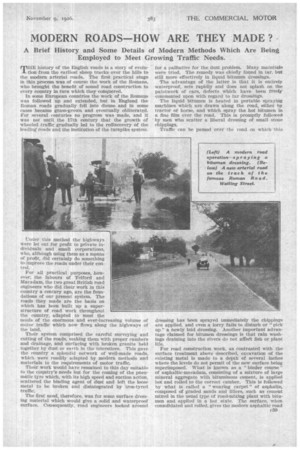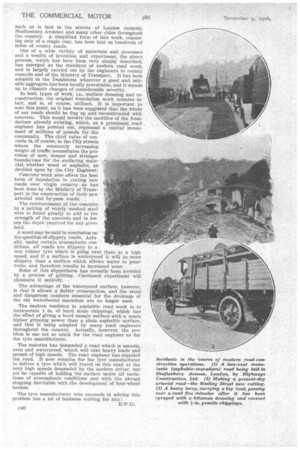MODERN ROADS-HOW ARE THEY MADE?
Page 121

Page 122

If you've noticed an error in this article please click here to report it so we can fix it.
A Brief History and Some Details of Modern Methods Which Are Being Employed to Meet Growing Traffic Needs.
TLIE history of the English roads is a story of evolution from the earliest sheep tracks over the hills to the modern arterial roads. The first practical stage in this process was of course the work of the Romans, who brought the benefit of sound road construction to every country in turn which they conquered.
In some European countries the work of the Romans was followed up and extended, but in England the Roman .roads gradually fell into disuse and in some cases became grass-grown and eventually obliterated. For several centuries no progress was made, and it was not until the 17th century that the growth of wheeled traffic gradually led to the rediscovery of the leading roads and the institution of the turnpike system.
Untler this method the highways Were let out for profit to private individuals" and small corporations, who, although using them as a means of profit, did certainly do something to improve the roads under their control. .
For all practical purposes, however, the labours of Telford and Macadam, the two great British road engineers who did their work in this country a century ago, are the foundations of our present system. The roads they made are the basis on which has been built up a superstructure of road work throughout the country, adapted to meet the needs of the enormous and ever-increasing volume of motor traffic which now flows along the highways of the land.
Their system comprised the careful surveying and cutting of the roads, making them with proper cambers and drainage, and surfacing with broken granite held together by dust or earth in the interstices. This gave the country a splendid network of well-made roads, which were readily adapted by modern methods and materials to the requirements of motor traffic.
Their work would have remained to this day suitable to the country's needs but for the coming of the pneumale tyre which, with its high speed and suction action, scattered the binding agent of dust and left the loose metal to be broken and disintegrated by iron-tyred traffic.
The first need, therefore, was for some surface dressing material which would give a solid and waterproof surface. Consequently, road engineers looked around for a palliative for the .dust problem. Many materials were tried. The remedy was chiefly found in tar, but still more effectively in liquid bitumen dressings..
The advantage of the latter is that it is entirely waterproof, sets rapidly and does not splash on the paintwork of cars, defects which have been freely • commented upon with regard to tar dressings.
The liquid bitumen is heated in portable spraying machines which are drawn along the road, either by tractor or horse, and which spray the hot bitumen in a fine film over the road. This is promptly followerl by men who scatter a liberal dressing of small stone chippings.
Traffic can be passed over the road on which this
dressing has been sprayed immediately the chippings are applied, and even a lorry, fails to disturb or "pick up" a newly laid dressing. Another important advantage claimed for bitumen dressings is that rain washings draining into the rivers do not affect fish or plant life.
For road construction work, as contrasted with the surface treatment above described, excavation of the existing metal is made to a depth of several inches where the levels do not permit of the new surface being superimposed. What is known as a "binder course " of asphaltic-macadam, consisting of a mixture of large mineral aggregate with bituminous cement, is applied hot and rolled to the correct camber. This is followed by what is called a "wearing carpet" of asplialte, composed of graded sands and fillers, such as cement mixed in the usual type of road-mixing plant with bitumen and applied in a hot state. The surface, when consolidated and rolled, gives the rxiodern asphaltic road such as is laid in the streets of London (notably Shaftesbury Avenue} and many other cities throughout the country. A simplified form of this work, consisting only of a single coat, has been laid on hundreds of miles of county roads.
Out of a wide variety of materials and processes and a wealth of invention and experiment, the above process, which has here been very simply described, has emerged as the standard of modern road work, and is largely carried out by the engineers to county councils and of the Ministry of Transport. It has been adopted in the Dominions wherever a good and suitable aggregate has been locally procurable, and it stands up to climatic changes of considerable severity.
In both types of work, i.e., surface dressing and reconstruction, the original foundation work remains intact, and is, of course, utilized. It is important to note this point, as it has been suggested that the whole of our roads should be dug up and reconstructed with concrete. This would involve the sacrifice of the foundations already existing, which, as a prominent road engineer has pointed out, represent a capital investment of millions of pounds for the community. The chief value of concrete is, of course, in the City streets where the constantly increasing weight of traffic necessitates the provision of new, deeper and stronger foundations for the surfacing material, whether wood or asphalte, as decided upon by the City Engineer.
Concrete -work also offers the best form of foundation in cutting new roads over virgin country as has been done by the Ministry of Transport in the construction of their new arterial and by-pass roads.
The reinforcement of the concrete by a netting of widely meshed steel wire is found greatly to add to the strength of the concrete and to lessen the depth required for any given load.
A word may be said in coraclusion on the question of slippery roads. Actually, under certain atmospheric conditions, all roads are slippery to a wet rubber tyre which is going over them at a high speed, and if a surface is waterproof it will be more slippery than a surface which allows water to penetrate, and therefore results in increased wear.
Some of this slipperiness has recently been avoided by a process of gritting. Continued experiment will eliminate it entirely.
The advantage of the waterproof surface, however, is that it allows a flatter cross-section, and the steep and dangerous cambers essential for the drainage of the old waterbound macadam are no longer used.
The thodern tendency in asphaltic road work is to incorporate in. of hard stone chippings, which has the effect of giving a hard mosaic surface with a much higher gripping power than a plain asphaltic surface, and this is being adopted by many roadengineers throughout the country. Actually, however, the problem is one not so much for the road engineer as for the tyre manufacturer.
The motorist has demanded a road which is smooth, even and waterproof, which will take heavy loads and permit of high speeds. The road engineer has supplied the road. It now remains for the tyre manufacturer to deliver a tyre which will travel on this road at the very high speeds demanded by the modern driver, but yet be capable of holding the surface under all variations of atmospheric 'conditions and with the abrupt stopping inevitable -with the development of four-wheel brakes.
The tyre manufacturer who succeeds in solving this problem has a lot of business waiting for him E.W.D.












































































































































































































